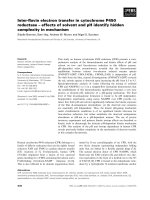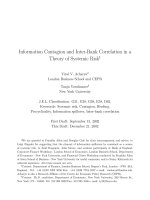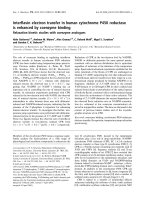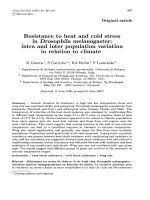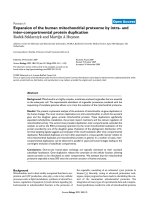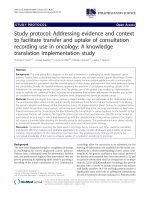Philanthropy and inter generational wealth transfer
Bạn đang xem bản rút gọn của tài liệu. Xem và tải ngay bản đầy đủ của tài liệu tại đây (1.34 MB, 9 trang )
Deutsche Asset
& Wealth Management
www.DeAWM.com
S4
SPECIAL ISSUE
Philanthropy and inter-generational wealth transfer
Global Financial Institute
Your entry to in-depth
knowledge in finance
Dr. Paul Kielstra
2 Philanthropy and inter-generational wealth transfer
Global Financial Institute
Introduction to “Global Capital Markets in 2030“
Deutsche Asset & Wealth Management’s Global
markets face weakening demand in many mature
Financial Institute asked the Economist Intelli-
markets.
gence Unit to produce a series of white papers,
custom articles, and info-graphics focused spe-
In short, while the world’s stock of financial assets
cifically on global capital market trends in 2030.
(e.g.
stocks,
bonds,
currency
and
commodity
futures) is growing, the pattern of that growth sugWhile overall growth has resumed, and the
gests that major shifts lie ahead in the shape of capi-
value traded on capital markets is astoundingly
tal markets.
large (the world’s financial stock grew to $212
trillion by the end of 2010, according to McKin-
This series of studies by Global Financial Institute
sey & Company) since the global financial crisis
and the Economist Intelligence Unit aims to offer
of 2008, the new growth has been driven mainly
deep insights into the long term future of capital
by
and
markets. It will employ both secondary and primary
by a $4.4 trillion increase in sovereign debt in
research, based on surveys and interviews with
2010. The trends are clear: Emerging markets,
leading institutional investors, corporate executives,
particularly in Asia, are driving capital-raising; in
bankers, academics, regulators, and others who will
many places debt markets are fragile due to the
influence the future of capital markets.
expansion
in
developing
economies,
large component of government debt; and stock
3 Paper tigers: Chinese and Indian capital markets
Global Financial Institute
Introduction to Global Financial Institute
Global Financial Institute was launched in Novem-
institutions are hundreds of years old, the per-
ber 2011. It is a new-concept think tank that seeks
fect place to go to for long-term insight into the
to foster a unique category of thought leadership
global economy. Furthermore, in order to present
for professional and individual investors by effec-
a well-balanced perspective, the publications span
tively and tastefully combining the perspectives of
a wide variety of academic fields from macroeco-
two worlds: the world of investing and the world
nomics and finance to sociology. Deutsche Asset
of academia. While primarily targeting an audi-
& Wealth Management invites you to check the
ence within the international fund investor com-
Global
munity,
publications
white papers, interviews, videos, podcasts, and
are nonetheless highly relevant to anyone who is
more from Deutsche Asset & Wealth Manage-
interested
long-term
ment’s Co-Chief Investment Officer of Asset Man-
views on the economic, political, financial, and
agement Dr. Asoka Wöhrmann, CIO Office Chief
social issues facing the world. To accomplish this
Economist
mission,
Global
in
Financial
Institute’s
independent,
Global
Financial
educated,
Institute’s
Financial
Institute
Johannes
website
Müller,
and
regularly
for
distinguished
publications
professors from institutions like the University of
combine the views of Deutsche Asset & Wealth
Cambridge, the University of California Berkeley,
Management’s
those
the University of Zurich and many more, all made
of leading academic institutions in Europe, the
investment
experts
with
relevant and reader-friendly for investment profes-
United States, and Asia. Many of these academic
sionals like you.
About the Economist Intelligence Unit
The
the
a variety of pieces covering the financial services
world’s leading resource for economic and busi-
Economist
Intelligence
industry including the changing role relationship
ness research, forecasting and analysis. It provides
between the risk and finance function in banks,
accurate and impartial intelligence for companies,
preparing for the future bank customer, sanctions
government
agencies,
Unit
financial
(EIU)
is
and
compliance in the financial services industry, and
academic organisations around the globe, inspir-
institutions
the future of insurance. A published historian, Dr.
ing business leaders to act with confidence since
Kielstra has degrees in history from the Universi-
1946. EIU products include its flagship Country
ties of Toronto and Oxford, and a graduate diploma
Reports service, providing political and economic
in Economics from the London School of Econom-
analysis for 195 countries, and a portfolio of sub-
ics.
scription-based data and forecasting services. The
the charitable sector.
He has worked in business, academia, and
company also undertakes bespoke research and
analysis projects on individual markets and busi-
Brian Gardner is a Senior Editor with the EIU’s
ness sectors. The EIU is headquartered in London,
Thought Leadership Team. His work has covered a
UK, with offices in more than 40 cities and a net-
breadth of business strategy issues across indus-
work of some 650 country experts and analysts
tries ranging from energy and information tech-
worldwide. It operates independently as the busi-
nology to manufacturing and financial services. In
ness-to-business
Group,
this role, he provides analysis as well as editing,
the leading source of analysis on international
project management and the occasional speaking
business and world affairs.
role. Prior work included leading investigations
arm
of The
Economist
into energy systems, governance and regulatory
This article was written by Dr. Paul Kielstra and
regimes. Before that he consulted for the Commit-
edited by Brian Gardner.
tee on Global Thought and the Joint US-China Collaboration on Clean Energy. He holds a master’s
Dr. Paul Kielstra is a Contributing Editor at the
degree from Columbia University in New York City
Economist Intelligence Unit. He has written on
and a bachelor’s degree from American University
a wide range of topics, from the implications of
in Washington, DC. He also contributes to The
political violence for business, through the eco-
Economist Group’s management thinking portal.
nomic costs of diabetes. HIs work has included
4 Philanthropy and inter-generational wealth transfer
Global Financial Institute
Philanthropy and inter-generational
wealth transfer
Written by
A Global Financial Institute research paper written by the Economist
Intelligence Unit
June 2014
A growing interest in giving
indications that there is a growing level of philanthropy
Capital is ultimately only a tool rather than an end in itself
among the wealthy. One is an apparent increase in the
and nothing quite focuses the mind on this limitation quite
establishment of family foundations—a common vehicle
like mortality. For those of high net worth, the problem of
for high-net-worth families to channel their giving. In 2000
not being able to take it with you has, if anything, grown
the Foundation Centre, an American organisation that
more acute in recent years, even with amid the economic
studies philanthropy, found 24,434 grant-making foun-
downturn. According to Cap Gemini’s World Wealth Report
dations “with measurable donor or donor-family involve-
the global number of millionaires has risen from 7.2m
ment” in the US. By 2010 the number had risen to 38,671,
holding US$26.7trn in investable wealth in 2002 to 12m
representing an increase of 58%. A 2009 study of family
with US$46.2trn in 2012.
foundations in several European countries, meanwhile,
found signs of a growing number of such organisations in
Much of this wealth will eventually be transferred to later
the UK and Italy.2 Entrepreneur-established foundations
generations of the same family. In recent years, however,
have even begun to appear in Asia’s emerging markets.3
notes Kelin Gersick—a US-based consultant and expert
on cross-generational change in family firms, as well as in
Such indications of growth are consistent with the impres-
family philanthropy—increasingly the focus of discussions
sions of those in the field. Mr Gersick notes that over the
by the families of wealthy entrepreneurs has shifted from
past two decades the role of philanthropy in the planning
the creation and preservation of wealth to its appropriate
of transgenerational wealth transfer “has seemed to be
and meaningful use. This “brings philanthropy more into
increasing”. Moreover, despite inevitable cultural varia-
the centre of the conversation” about wealth management
tions, he believes that the idea that “the mark of a family
and its transfer, Mr Gersick says. The billions of dollars that
of quality includes the issue of effective, well-managed
Bill Gates and Warren Buffett have given through the for-
philanthropy is becoming a global cultural phenomenon.”
mer’s foundation are the most prominent and largest high-
Theresa Lloyd, a British philanthropy consultant and co-
profile donations. They are not unique, however, or even
author of Richer Lives: Why rich people give, also says that
isolated exceptions. Li Ka shing, a Hong Kong property
family philanthropy is “undoubtedly more prominent and
tycoon, and India’s Azim Premji have both also given away
the number of people setting up foundations as a perma-
billions, while a recent global survey of high-net-worth
nent and strategic commitment to family philanthropy has
individuals found that 17% of those with over US$20m in
been increasing.”
investment assets had their own charitable foundations.1
Philanthropy as a tool in inter-generational wealth transfer
Such activity is not, in itself, new. Some well-endowed insti-
The drivers of philanthropy by wealthy individuals are
tutions that were created in this way, such as the Rocke-
complex and vary widely by culture: personal experi-
feller Foundation in the US and the Rowntree Trusts in Brit-
ence with an area of need or religion tend to be a leading
ain, have existed for over a century. However, there are also
motivators in the Middle East, while a desire to give back
BNP Paribas Individual Philanthropy Index: Measuring Commitment in Europe, Asia, Middle East. BNP Paribas, May 2013.
Pharoah, C. (2009). Family Foundation Philanthropy 2009: UK, Germany, Italy, US. London: Alliance Publishing Trust.
3
UBS-INSEAD Study on Family Philanthropy in Asia. UBS-INSEAD, 2011, “Rich more willing to set up family foundations,” People’s Daily
Online, May 16th 2011.
1
2
5 Philanthropy and inter-generational wealth transfer
Global Financial Institute
and general feelings of altruism are the main factors in Asia and
Once they are wrestling with such questions, parents in high-
Europe respectively.4 Linking all of these motivations is the idea
net-worth families, according to Ms Lloyd, will “see the creation
that rich donors are genuinely seeking to help their wider societ-
of a foundation as not just something good for their own giving
ies, rather than looking for secondary benefits such as reduced
but as a solution” for other issues. In particular, involving younger
taxes. Mr Gersick notes, “most families that have philanthropy as
relatives in the running of family foundations, or in philanthropy
part of their family system want to be responsible to their com-
more generally, can help to address a range of inter-related family
munities. They see it as one mark of an honourable lifestyle.” For
issues that frequently revolve around preparing children for the
some, wealth creation and giving back are inextricably inter-
substantial challenges of maintaining inherited wealth. The think-
twined. Grant Gordon is a philanthropist and a member of the
ing behind such use of philanthropy by families, says Ms Lloyd,
fifth generation to work in the family business, William Grant &
is “almost a paradox. If you give some away, your family is more
Sons, a Scottish distiller. He explains that the company’s success
likely to hold onto the rest through more generations.” In other
has taught his family the importance of the local community in
words, the money being given to good causes can at the same
which it operates and has instilled a sense of responsibility for it.
time provide an opportunity for lessons in entrepreneurship, per-
One form this awareness takes is a desire to support the areas in
sonal and civic responsibility as well as wealth management.
which it operates, and to create more opportunities for people
there to thrive.
One of the most common family purposes for structured philanthropy is, notes Mr Gordon, “to instil in the next generation the
Within this context of a genuine desire to do good, the way that
family values—around the importance of community and the
philanthropy is structured by high-net-worth families plays a vari-
responsibilities of beneficiaries [of wealth]—that you may have
ety of strategic roles in inter-generational wealth transfer. This, as
received and which you have tried to build on and maintain.” The
much as the tax advantages found in many jurisdictions, explains
Rumi Foundation is a case in point. Rumi Verjee made his own
the increasing use of family foundations. Mr Gersick states that,
wealth after his family’s forced exit from Idi Amin-ruled Uganda.
especially after the first generation produces substantial wealth,
Before the dictator confiscated most of its assets, however, sev-
often through an operating company, a family office or holding
eral generations in Africa and in the family’s native home of India
company frequently emerges as the centre of family activity.
had been very well-off and, consistent with their Ismaili Muslim
“Then philanthropy becomes one of the structural components
beliefs, engaged in substantial community-support and reli-
of the family enterprise system”, with a philanthropic foundation
gious giving. As Rumi puts it, “history, culture within the family,
often one of several significant entities.
past philanthropy, and religion—that is what drives older family
members to make sure values do transfer down to other genera-
This shift has had an important psychological impact for both
tions. Involving members of the next generation and giving them
current business decisions and planning for the future. Lord Rumi
responsibility helps to inculcate those values.”
Verjee is a successful British entrepreneur who established the
Rumi Foundation in 2006, which is chaired by his nephew, Jay
Jay Verjee agrees. He sees his appointment as part of an effort
Verjee, a Canadian businessman. The foundation’s work, says
to instil “a culture of giving back and thinking of others, which
Lord Verjee, has integrated with family business activities and
is something the older generation is trying to make sure the
succession-planning in several ways.” It gives a rigour in thinking
younger one understands and prioritises. [In this way, the founda-
about wealth-transfer issues, looking at questions like, ‘When is
tion acts] as a place to put cultural values in. I love that my cousins
enough, enough?’ and ‘How much do you give?’ It really drives
are interested in getting involved and, from the age of 16, think-
you to question those sorts of issues.” He adds that, more gener-
ing about projects.”
ally, “setting up a foundation has helped a lot to bring discipline
into entrepreneurial and business activities,” as philanthropic
In addition to educating members of younger generations
activity encourages a long-term vision.
on desired moral values, foundations and other forms of
2014 BNP Paribas Individual Philanthropy Index: Philanthropic Journeys :The Importance of Timing. BNP Paribas, February 2014. For a
more nuanced examination of giving by high-net-worth individuals in one country see Breeze, B. and Lloyd, T. (2013) Richer Livers: Why
rich people give. London: Directory of Social Change.
4
6 Philanthropy and inter-generational wealth transfer
Global Financial Institute
high-net-worth family philanthropy are sometimes expected to
Of his own generation, he notes a number of cousins “from quite
serve as a financial, leadership and collaboration training ground.
different walks of life and not working in family business for
Ms Lloyd explains that “running a family foundation requires dif-
whom giving is the one part of the family enterprise that they
ficult decisions” and some families feel that such involvement will
care most deeply about.” The younger generation of some 30
mean that younger relatives are less likely to waste other parts
cousins, meanwhile, get together once a year to decide what to
of the family fortune. Mr Gersick adds that, given how rarely
do with a defined pot of charitable money “as a team exercise”.
younger family members receive training in governance issues,
He notes that these philanthropic activities, as well as the distinct
“for the members of all generations in an extended family to
ones in which his nuclear family engages, have made his own
have the opportunity to work together, make decisions, manage
children—who are not interested in a career in the business—
money, and argue over policies, [the experience] has value.” More-
”more engaged in the broader family enterprise”. Philanthropy
over, he says, this work can reveal hidden human capital among
can even have a strong impact across several generations. Jay
family members, which can then be applied elsewhere.
Verjee recalls the effect that seeing a mosque in Mombasa which
his great-grandfather had paid to erect in 1850 had on him. “The
Mr Gersick warns, however, that foundations are not panaceas.
culture of giving is what makes me most proud to be part of our
Senior generations of high-net-worth families often see founda-
family,” he says.
tions, or involvement in charitable work more generally, as ways
to give moral and management lessons. “To a point they can fulfil
This does not mean that families necessarily have to agree on
those functions,” he believes, “but not as much as seniors believe.”
a specific cause to support. Rather, the process of philanthropy
With regard to ethical values, he notes that when the establish-
itself has an impact. Ms Lloyd recalls one family she worked with:
ment of a foundation is an isolated activity, inconsistent with
the parents said that during the adolescence of their four chil-
other family behaviour, “the kids don’t believe [the supposed
dren, the only time everyone seemed willing to talk together was
moral lesson] anyway. Creating a foundation by itself does not
about their philanthropy, despite the fact that they supported
create—or repair—a family culture.”
very different causes. But formal philanthropic structures can also
help. The Rumi Foundation, for example, does so by providing a
Similarly, he adds, family foundations and companies are not
focus for family action. Both Verjees note, for example, that dis-
identical, and so running the former does not in itself create the
persal across geographies and even cultures—a common issue
capacity to run the latter well. Mr Gordon agrees. Although he
for high-net-worth families—can impede a group’s focus on giv-
believes that involvement in a family’s charitable activities pro-
ing. As Jay Verjee puts it, “The most difficult thing for my genera-
vides good experience and “a solid training ground for gover-
tion is that we are all over the place. Philanthropy is easier when
nance,” he notes that “it is not a career development move”. Both
you are all together.”
for its own intrinsic value and the lessons it can teach, the more
experience family members have of well-run, thoughtful philan-
Finally, especially for those of very high net worth looking to
thropy the better. Doing so does not, however, create the condi-
secure the welfare of future generations, giving money away can,
tions for effective inter-generational wealth transfer in isolation.
in some cases, be a means of protecting heirs from the hazards
inherent in wealth transfer. From Andrew Carnegie to Mr Gates,
Nevertheless, if done well, many families also find that philan-
a number of very successful entrepreneurs have turned to phi-
thropy can provide a shared activity around which generations
lanthropy after setting aside what they consider to be sufficient
can coalesce—an important good in itself and an aid in build-
resources for the next generation. For them, the legacy is the
ing relationships that ease the broader process of wealth transfer.
example, not simply the income. Mr Buffett, for example, has even
Although “it doesn’t work every time,” Mr Gordon calls philan-
found an interesting way to square the circle of philanthropy and
thropy a “potentially powerful way of engaging family members”.
heirs by funding charitable foundations run by his three children
7 Philanthropy and inter-generational wealth transfer
through gifts worth well over US$1bn to each.
Global Financial Institute
tends to be raised first by a younger family member. Nevertheless, especially where an entrepreneurial founder of a foundation
The changing face of philanthropy
is still alive, such strategies quickly resonate with the “return on
Even as one of the secondary goals of high-net-worth family phi-
investment” orientation that the senior leader used to build the
lanthropy is to have a positive impact on younger family mem-
enterprise. “I wouldn’t say there is a lot of resistance [from older
bers, the newer generation is having its own impact on how phi-
individuals],” he adds, “it is more the idea [that] this business pro-
lanthropy is practised.
cess to philanthropy tends to enter discussion from the younger
generations.” Rather than a one-way transfer of knowledge, joint
In recent years several new philanthropic strategies have grown
philanthropy efforts can create an exchange between family
in popularity among those with the resources to pursue them.
members.
These typically involve active engagement with the charitable
enterprise rather than simply writing a cheque. The most well
This is consistent with the experience of the Verjees. Jay Verjee
known—philanthrocapitalism, also known as venture philan-
says that he and Lord Verjee rarely disagree on particular causes,
thropy—involves using business techniques, as well as investing
but differ only in keeping up with philanthropic trends. “I try to
time and energy, in order to bring to scale solutions to problems
look at impact investment and social entrepreneurship. Rumi
which are best dealt with through charities rather than busi-
has a more traditional view,” which has shaped the foundation’s
nesses. Further blurring the lines between business and philan-
approach to date. His uncle is not even sure that this is such a dif-
thropy has been the growth of social or impact investment, which
ference. He believes that “philanthropy is changing dramatically
typically involves putting money into an organisation with a view
and the world is changing.” He sees a broader shift of attitude
to a social return as well as an economic one. The vehicle in this
in which older individuals share. Like the younger generation, “I
case can be a non-governmental organisation, a traditional com-
now think more about the social impact of a lot of what I do” than
pany or a social enterprise—organisations using market-based
he did in his own youth, he says.
techniques that generate profits in pursuit of a specific social
goal.
In the coming years, an increasing number of high-net-worth
individuals will be considering the ultimate destinations of a
These developments are coming into family philanthropy largely
growing amount of capital. Part of this money will go to philan-
through younger individuals. According to Ms Lloyd, “[there is]
thropy. Although the main driver will be a charitable impulse, it
no question that there are generational differences. The older
will make sense to donate these funds in a way that helps to incul-
generation tended to be more traditional grant-makers. Emerg-
cate important values and skills in the family’s younger genera-
ing donors are more interested in social and impact investing, in
tion. If done well, this will not only help the latter to manage their
spending more time, setting up their own operational organisa-
entire inheritance better in future, but it can also widen perspec-
tions, rolling up their sleeves.” The difference, however, is one of
tives on giving in the present—a greatly enhanced legacy from
exposure to new ideas rather than a fixed strategic vision. Mr Ger-
one generation to another.
sick notes that, in his experience, the idea of venture philanthropy
8 Disclaimer
Global Financial Institute
Deutsche Asset & Wealth Management represents the asset management and wealth management activities conducted
by Deutsche Bank AG or any of its subsidiaries.
Clients will be provided Deutsche Asset & Wealth Management products
or services by one or more legal entities that will be identified to clients pursuant to the contracts, agreements, offering
materials or other documentation relevant to such products or services.
This material was prepared without regard to the specific objectives, financial situation or needs of any particular person
who may receive it. It is intended for informational purposes only and it is not intended that it be relied on to make any
investment decision. It does not constitute investment advice or a recommendation or an offer or solicitation and is not
the basis for any contract to purchase or sell any security or other instrument, or for Deutsche Bank AG and its affiliates
to enter into or arrange any type of transaction as a consequence of any information contained herein. Neither Deutsche
Bank AG nor any of its affiliates, gives any warranty as to the accuracy, reliability or completeness of information which is
contained in this document. Except insofar as liability under any statute cannot be excluded, no member of the Deutsche
Bank Group, the Issuer or any officer, employee or associate of them accepts any liability (whether arising in contract, in
tort or negligence or otherwise) for any error or omission in this document or for any resulting loss or damage whether
direct, indirect, consequential or otherwise suffered by the recipient of this document or any other person.
The opinions and views presented in this document are solely the views of the author and may differ from those of
Deutsche Asset & Wealth Management and the other business units of Deutsche Bank. The views expressed in this document constitute the author’s judgment at the time of issue and are subject to change. The value of shares/units and their
derived income may fall as well as rise. Past performance or any prediction or forecast is not indicative of future results.
Any forecasts provided herein are based upon the author’s opinion of the market at this date and are subject to change,
dependent on future changes in the market. Any prediction, projection or forecast on the economy, stock market, bond
market or the economic trends of the markets is not necessarily indicative of the future or likely performance. Investments
are subject to risks, including possible loss of principal amount invested.
Publication and distribution of this document may be subject to restrictions in certain jurisdictions.
© Deutsche Bank · June 2014
R-34278-1 (3/14)
Your input is important to us. For enquiries and feedback, please contact:
Dr. Henning Stein
Head of Global Financial Institute
